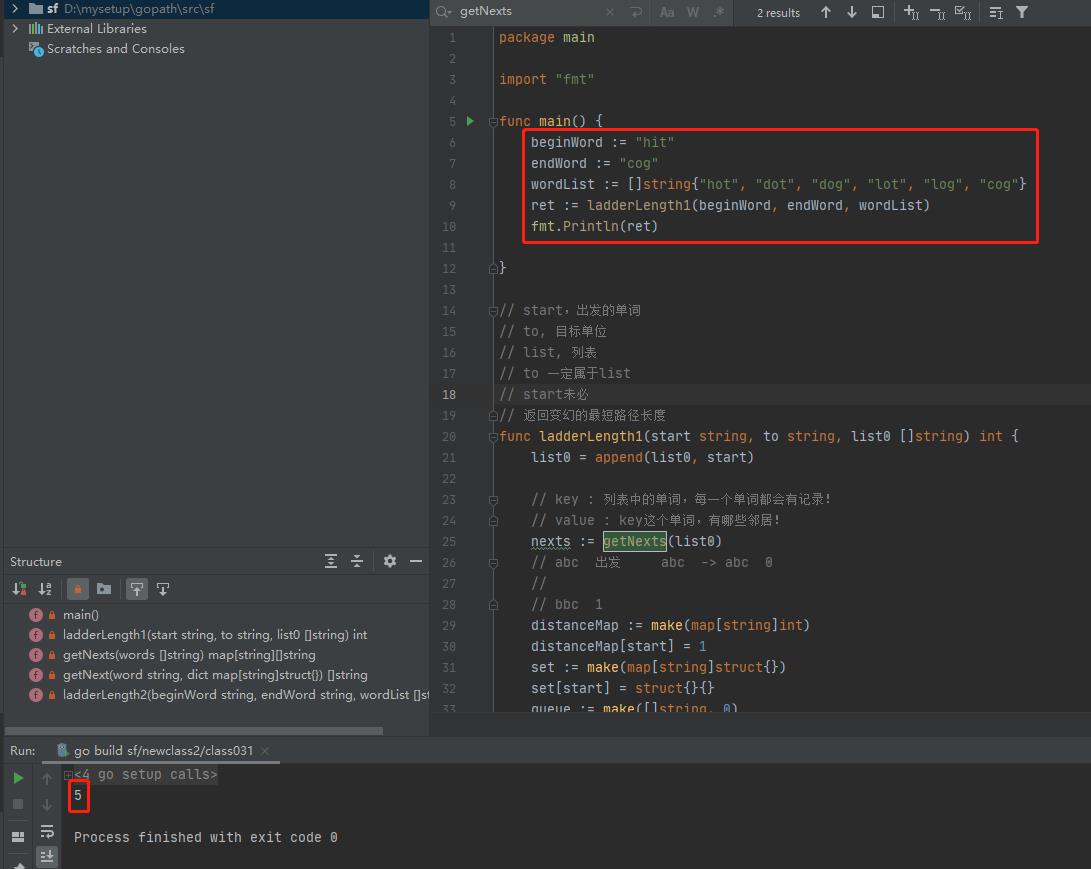2021-10-13:单词接龙。字典 wordList 中从单词 beginWord 和 endWord 的 转换序列 是一个按下述规格形成的序列:序列中第一个单词是 beginWord 。序列中最后
Posted 福大大架构师每日一题
tags:
篇首语:本文由小常识网(cha138.com)小编为大家整理,主要介绍了2021-10-13:单词接龙。字典 wordList 中从单词 beginWord 和 endWord 的 转换序列 是一个按下述规格形成的序列:序列中第一个单词是 beginWord 。序列中最后相关的知识,希望对你有一定的参考价值。
2021-10-13:单词接龙。字典 wordList 中从单词 beginWord 和 endWord 的 转换序列 是一个按下述规格形成的序列:序列中第一个单词是 beginWord 。序列中最后一个单词是 endWord 。每次转换只能改变一个字母。转换过程中的中间单词必须是字典 wordList 中的单词。给你两个单词 beginWord 和 endWord 和一个字典 wordList ,找到从 beginWord 到 endWord 的 最短转换序列 中的 单词数目 。如果不存在这样的转换序列,返回 0。力扣127。
福大大 答案2021-10-13:
宽度优先遍历。找邻居。
代码用golang编写。代码如下:
package main
import "fmt"
func main() {
beginWord := "hit"
endWord := "cog"
wordList := []string{"hot", "dot", "dog", "lot", "log", "cog"}
ret := ladderLength1(beginWord, endWord, wordList)
fmt.Println(ret)
}
// start,出发的单词
// to, 目标单位
// list, 列表
// to 一定属于list
// start未必
// 返回变幻的最短路径长度
func ladderLength1(start string, to string, list0 []string) int {
list0 = append(list0, start)
// key : 列表中的单词,每一个单词都会有记录!
// value : key这个单词,有哪些邻居!
nexts := getNexts(list0)
// abc 出发 abc -> abc 0
//
// bbc 1
distanceMap := make(map[string]int)
distanceMap[start] = 1
set := make(map[string]struct{})
set[start] = struct{}{}
queue := make([]string, 0)
queue = append(queue, start)
for len(queue) > 0 {
cur := queue[0]
queue = queue[1:]
distance := distanceMap[cur]
for _, next := range nexts[cur] {
if next == to {
return distance + 1
}
if _, ok := set[next]; !ok {
set[next] = struct{}{}
queue = append(queue, next)
distanceMap[next] = distance + 1
}
}
}
return 0
}
func getNexts(words []string) map[string][]string {
dict := make(map[string]struct{})
for _, word := range words {
dict[word] = struct{}{}
}
nexts := make(map[string][]string)
for i := 0; i < len(words); i++ {
nexts[words[i]] = getNext(words[i], dict)
}
return nexts
}
// 应该根据具体数据状况决定用什么来找邻居
// 1)如果字符串长度比较短,字符串数量比较多,以下方法适合
// 2)如果字符串长度比较长,字符串数量比较少,以下方法不适合
func getNext(word string, dict map[string]struct{}) []string {
res := make([]string, 0)
chs := []byte(word)
for i := 0; i < len(chs); i++ {
for cur := 'a'; cur <= 'z'; cur++ {
if chs[i] != byte(cur) {
tmp := chs[i]
chs[i] = byte(cur)
if _, ok := dict[fmt.Sprintf("%s", chs)]; ok {
res = append(res, fmt.Sprintf("%s", chs))
}
chs[i] = tmp
}
}
}
return res
}
func ladderLength2(beginWord string, endWord string, wordList []string) int {
dict := make(map[string]struct{})
for _, word := range wordList {
dict[word] = struct{}{}
}
if _, ok := dict[endWord]; !ok {
return 0
}
startSet := make(map[string]struct{})
endSet := make(map[string]struct{})
visit := make(map[string]struct{})
startSet[beginWord] = struct{}{}
endSet[endWord] = struct{}{}
for len0 := 2; len(startSet) > 0; len0++ {
// startSet是较小的,endSet是较大的
nextSet := make(map[string]struct{})
for w, _ := range startSet {
// w -> a(nextSet)
// a b c
// 0
// 1
// 2
for j := 0; j < len(w); j++ {
ch := []byte(w)
for c := 'a'; c <= 'z'; c++ {
if byte(c) != w[j] {
ch[j] = byte(c)
next := fmt.Sprintf("%c", ch)
if _, ok := endSet[next]; ok {
return len0
}
_, ok1 := dict[next]
_, ok2 := visit[next]
if ok1 && !ok2 {
nextSet[next] = struct{}{}
visit[next] = struct{}{}
}
}
}
}
}
// startSet(小) -> nextSet(某个大小) 和 endSet大小来比
//startSet = (nextSet.size() < endSet.size()) ? nextSet : endSet;
startSet = endSet
if len(nextSet) < len(endSet) {
startSet = nextSet
}
//endSet = (startSet == nextSet) ? endSet : nextSet;
b := len(startSet) == len(endSet)
if b {
for ss, _ := range startSet {
if _, ok := endSet[ss]; ok {
} else {
b = false
break
}
}
}
if !b {
endSet = nextSet
}
}
return 0
}
执行结果如下:

以上是关于2021-10-13:单词接龙。字典 wordList 中从单词 beginWord 和 endWord 的 转换序列 是一个按下述规格形成的序列:序列中第一个单词是 beginWord 。序列中最后的主要内容,如果未能解决你的问题,请参考以下文章